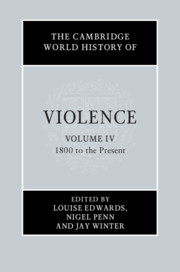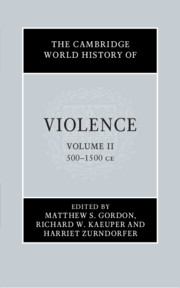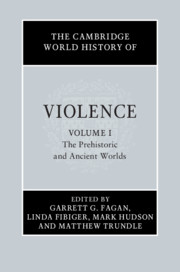Refine search
Actions for selected content:
15418 results in Military history
3 - Violence, Non-Violence, the State and the Nation: India, 1858–1958
- from Part I - Race, Religion and Nationalism
-
-
- Book:
- The Cambridge World History of Violence
- Published online:
- 13 March 2020
- Print publication:
- 26 March 2020, pp 68-87
-
- Chapter
- Export citation
Part V - Depictions of Violence
-
- Book:
- The Cambridge World History of Violence
- Published online:
- 13 March 2020
- Print publication:
- 26 March 2020, pp 513-675
-
- Chapter
- Export citation
5 - The Second World War and Its Aftermath
-
- Book:
- Nigeria and World War II
- Published online:
- 05 March 2020
- Print publication:
- 26 March 2020, pp 206-251
-
- Chapter
- Export citation
30 - ‘Never Forget that This Has Happened’: Remembering and Forgetting Violence
- from Part V - Representations and Constructions of Violence
-
-
- Book:
- The Cambridge World History of Violence
- Published online:
- 13 March 2020
- Print publication:
- 26 March 2020, pp 616-636
-
- Chapter
-
- You have access
- HTML
- Export citation
30 - Violence Is the Name of the [Bad] Game: The Downside of Human Nature as Reflected in Medieval Literature
- from Part V - Depictions of Violence
-
-
- Book:
- The Cambridge World History of Violence
- Published online:
- 13 March 2020
- Print publication:
- 26 March 2020, pp 623-644
-
- Chapter
- Export citation
Maps
-
- Book:
- The Cambridge World History of Violence
- Published online:
- 13 March 2020
- Print publication:
- 26 March 2020, pp xii-xii
-
- Chapter
- Export citation
Index
-
- Book:
- The Cambridge World History of Violence
- Published online:
- 13 March 2020
- Print publication:
- 26 March 2020, pp 704-740
-
- Chapter
- Export citation
Introduction
-
- Book:
- The Intelligence War against the IRA
- Published online:
- 05 March 2020
- Print publication:
- 26 March 2020, pp 1-14
-
- Chapter
- Export citation
Part I - Empire, Race and Ethnicity
-
- Book:
- The Cambridge World History of Violence
- Published online:
- 13 March 2020
- Print publication:
- 26 March 2020, pp 15-116
-
- Chapter
- Export citation
Copyright page
-
- Book:
- Nigeria and World War II
- Published online:
- 05 March 2020
- Print publication:
- 26 March 2020, pp iv-iv
-
- Chapter
- Export citation
4 - Racial Violence in the United States since the Civil War
- from Part I - Race, Religion and Nationalism
-
-
- Book:
- The Cambridge World History of Violence
- Published online:
- 13 March 2020
- Print publication:
- 26 March 2020, pp 88-109
-
- Chapter
- Export citation
8 - The Yogi’s Way of War
- from Part II - Cultures of War and Violence
-
-
- Book:
- The Cambridge World History of Violence
- Published online:
- 13 March 2020
- Print publication:
- 26 March 2020, pp 156-173
-
- Chapter
- Export citation
26 - Violence towards Heretics and Witches in Europe, 1022–1800
- from Part VI - Religious and Sacred Violence
-
-
- Book:
- The Cambridge World History of Violence
- Published online:
- 13 March 2020
- Print publication:
- 26 March 2020, pp 513-530
-
- Chapter
- Export citation
30 - Intercultural Emblems of Violence in the Spanish Colonisation of the Americas
- from Part VII - Representations and Constructions of Violence
-
-
- Book:
- The Cambridge World History of Violence
- Published online:
- 13 March 2020
- Print publication:
- 26 March 2020, pp 591-611
-
- Chapter
- Export citation

The Cambridge World History of Violence
-
- Published online:
- 13 March 2020
- Print publication:
- 26 March 2020

The Cambridge World History of Violence
-
- Published online:
- 13 March 2020
- Print publication:
- 26 March 2020

The Cambridge World History of Violence
-
- Published online:
- 13 March 2020
- Print publication:
- 26 March 2020

The Cambridge World History of Violence
-
- Published online:
- 13 March 2020
- Print publication:
- 26 March 2020
Tables
-
- Book:
- The Company Fortress
- Published by:
- Amsterdam University Press
- Published online:
- 04 January 2025
- Print publication:
- 11 March 2020, pp xi-xii
-
- Chapter
- Export citation
Bibliography
-
- Book:
- The Company Fortress
- Published by:
- Amsterdam University Press
- Published online:
- 04 January 2025
- Print publication:
- 11 March 2020, pp 265-284
-
- Chapter
- Export citation
